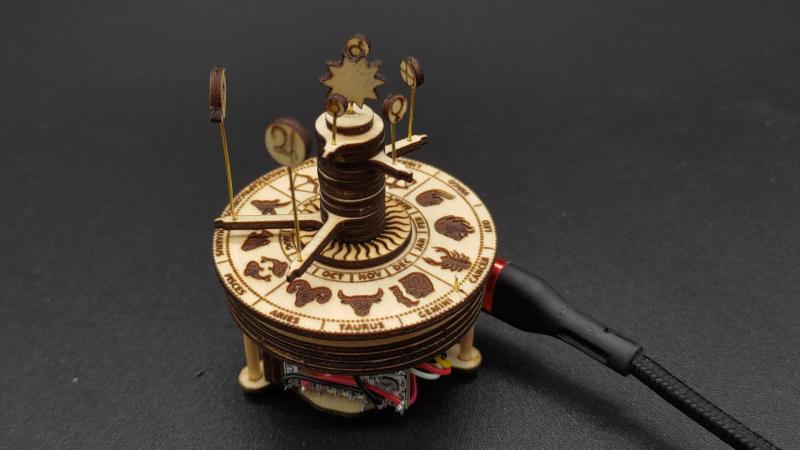[Frans] claims to have made the world’s smallest wooden orrery. We won’t take a position on that — such things are best left up to the good folks at Guinness. But given that the whole thing is seriously in danger of being dwarfed by a USB-C connector, we’d say he’s got a pretty good shot at that record.
The key to keeping this planetarium so petite while making it largely out of wood is to eschew the complex gear trains that usually bring the Music of the Spheres to life in such devices. The layered base of the orrery, with pieces cut from a sheet of basswood using a laser cutter, contains a single tiny stepper motor and just two gears. A zodiac disc sits atop the base and is the only driven element in the orrery; every other celestial body moves thanks to a pin set into the zodiac disc. An ESP32 C3 contacts a NASA feed once a day to get the relative positions of the planets and uses the zodiac disk to arrange everything nicely for the day. The video below shows the “Planet Spinner” in action.
We love the look of this project; the burnt edges and lightly smoked surface of the laser-cut wooden parts look fantastic, and the contrast with the brass wires is striking. We’ve seen an orrery or two around here, executed in everything from solid brass to Lego, but this one really tickled our fancy.















Nice and simple, but I prefer it when you can speed up time to see the planets spin around with appropriate relative velocities. Doing it with this one would require a time lapse.
I always thought every makersps e should have a giant laser cut wooden orrery hanging from the ceiling, felt like it would be a good way to attract membership. Never seen anyone do it though. This is cool
The Eise Eisinga Planetarium is the oldest (still running) orrery in the world. The mechanics are built into the ceiling of a large room and the planets are suspended from their gears. Unlike what DrewTheMachinist imagines, no parts of this planetarium were laser-cut. This orrery also shows state of the moon, date, time, tide. It runs in real time (it cannot show you what the planet configuration would be at some other date).
This marvel is located in Franeker, the Netherlands and is absolutely worth a visit if you’re in the neighborhood. From Franeker railway station it is a 10 minute walk to the Eise Eisinga Planetarium museum.
Indeed, orreries are used to show the relative speed of motion and this doesn’t do that. This on the other hand shows the exact position (which orreries have a hard time doing, if at all) That’s why I called it a Planet Spinner,
I really like this concept.
“good folks at Guinness.”?!
You’re joking right? Are we talking about the same Guinness Book of World Records “Guinness” who invent ridiculous new world records for large companies, autocrats, regimes and so on?
-> https://www.youtube.com/watch?v=-9QYu8LtH2E&t=752s
Pretty cool!
If you want to remove the dependency on the Internet, computing the positions of the planets “accurately enough” is not that difficult. In the code linked below, you would want to use xecl, yecl, zecl, which are the ecliptic coordinates.
https://www.celestialprogramming.com/planets_with_keplers_equation.html
Oh, that’s a pretty nice piece of code. Thank you for that! I would have used that for sure. Still it sounds pretty cool to get the data from NASA directly.
The device still needs internet, because it doesn’t have a real-time-clock on board. It gets its time via ntp from a time server. It also uses WiFi to allow users to enter any date
That is, of course, based on the same principle used by a rotary combination lock: I’ve been wondering for a while whether it could be done but was focusing more on stacked discs.
Having the pin pick up the arms rather than underlying discs is, of course, very much in line with the classic orreries on display in numerous museums.
I sincerely congratulate IllusionManager on an extremely effective build.